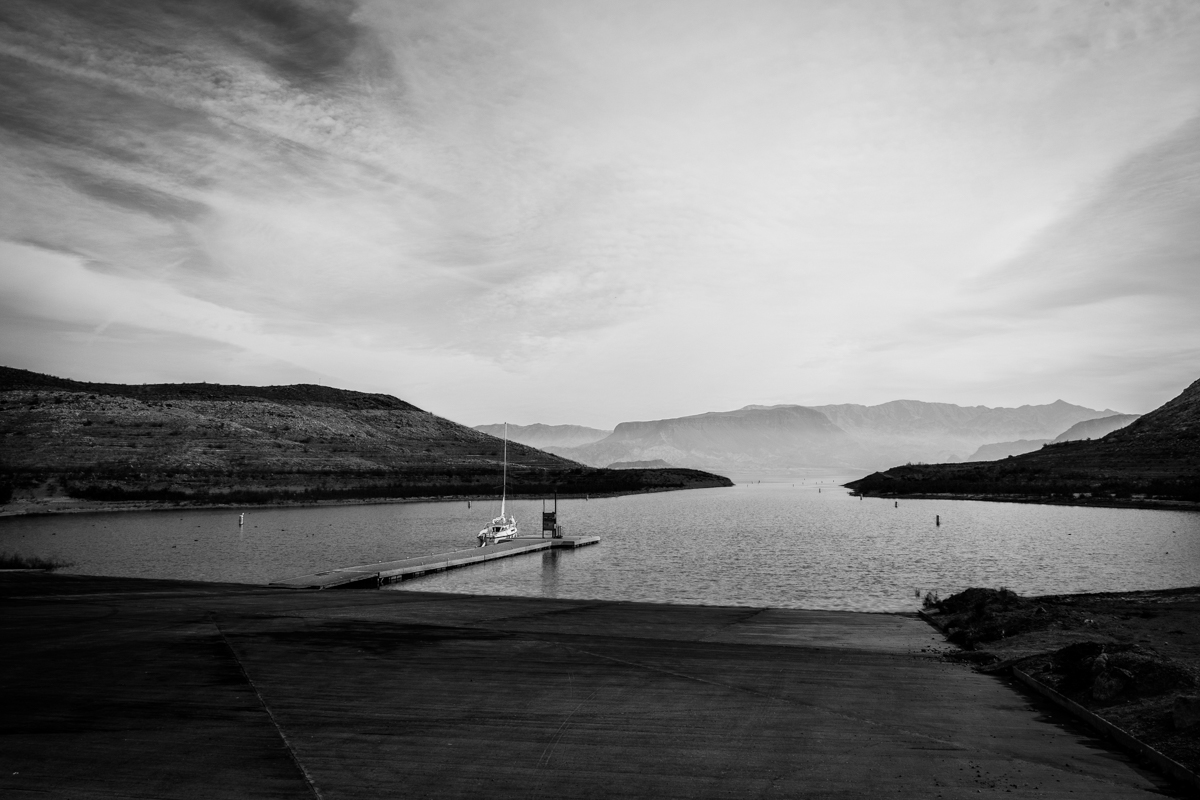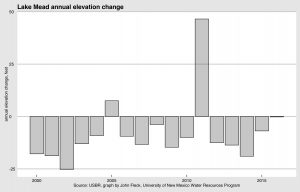
Boulder Harbor, Lake Mead, December 2016, © John Fleck
There’s a “half full/half empty” joke in here somewhere.
The reservoirs of the Colorado River Basin are 49 percent full/51 percent empty right now (data pdf). Despite another bad runoff year, that’s pretty much exactly where they were at the end of 2015.
Let’s go with half full then, shall we? We’ve come within a couple of inches’ elevation of halting Lake Mead’s decline. It still shrank, and absent further action it will continue to do so.
But we are close, and we can see what “further action” looks like. As I write this on New Years Eve, it looks like Mead will end 2016 at elevation 1,080 feet and change above sea level, just a couple of inches below where it ended 2015. Maybe the experience of the last couple of years suggests “inexorable” is no longer the right word?
The year-end number is still a record – the lowest since 1936, when they were first filling the big reservoir. (Despair?) But in a year with below average precipitation in the Colorado River Basin (89 percent of average into Lake Powell), this represents real progress in managing the system. “Normal” for the 21st century (the median) is an annual drop of 12-plus feet in the reservoir. It’s only gone up twice since 2000. Both times were unusually wet years. A year in which, despite sub par runoff, Lake Mead doesn’t keep dropping is a step in the right direction.
Looking at the basin more broadly, total storage at years’ end sits at 29.453 million acre feet, just a tad below 29.693 million acre feet last year at this time. This despite Upper Colorado River Basin runoff that was more than 1 million acre feet below average.
A few things are going on here:
- Arizona only took 2.61 million acre feet of water in 2016, 93 percent of its full allotment.
- Nevada only took 235,000 acre feet, 78 percent of its full allotment.
Over the last couple of years, the combined conservation efforts of Arizona and Nevada are equivalent to about 8 feet of elevation in Mead – water that is currently sitting in the reservoir.
Lake Mead also has benefited from “bonus water” released from Lake Powell upstream. Under a deal the Colorado River Basin states cut back in 2007, in some years extra water is released from Lake Powell down through the Grand Canyon to Lake Mead, in an effort to balance the contents of the two big reservoirs. That has happened the last two years, and the forecast calls for it again in 2017.
The latest projections for next year suggest Mead will decline again absent bigger conservation measures. With a larger water conservation deal close and probably inevitable, we seem close to turning that important corner. A year in which Mead only dropped two inches despite below-average runoff suggests that it can be done.
When people have less water, as I have previously written, they use less water.


Well…and as of now, we here in Colorado (optimistically) have a pretty solid snow year coming. I know, it’s not nothing until sometime in March when the snow year is officially called, but c’mon, it’s New Years, we need a little optimism around here.
So given that (possibility) that would also buy Mead a little bit of time, right?
SE
Sinjin –
I am pained to admit that, when I was a daily journalist, I found myself quietly rooting for bad snowpacks, because that meant fertile ground for scary drought stories in the newspaper. Now that I’m so invested in water solutions world, I’ve completely switched sides. Go snow!
So yes, I’m excited too, even this early in the season, by the Colorado snowpack.